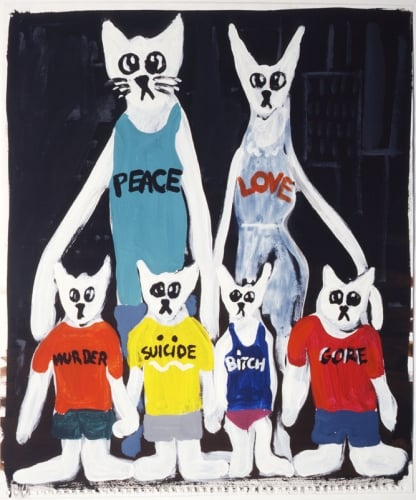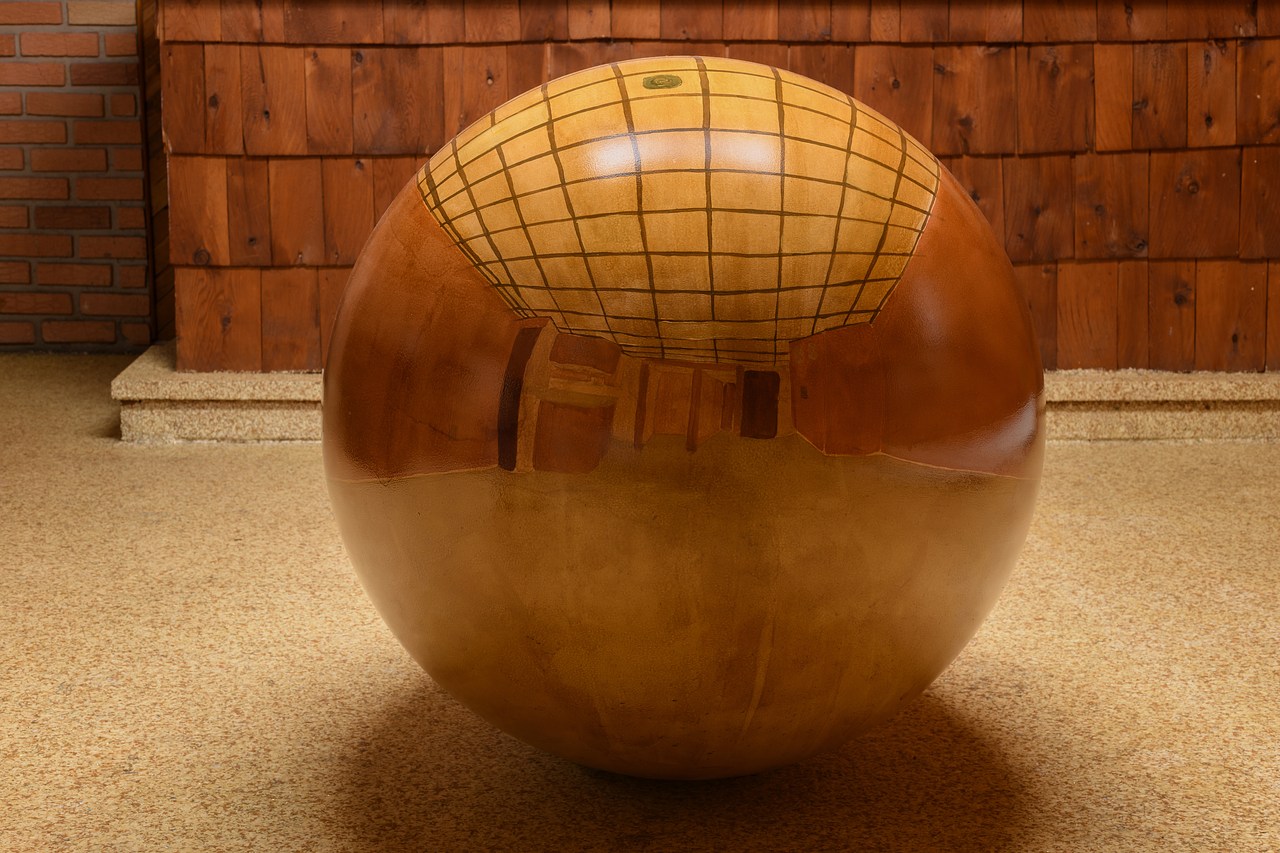
© » KADIST
Matthieu Saladin
Drawing & Print (Drawing & Print)
L’effeuillage des effacements (The Stripping of Erasures) 2016, presents a piles of posters gathered in decreasing chronological order from 2015 to 2400 B. C. of 150 historical episodes of debt cancellation (one event per poster). Unlike usual stacks, each poster is different, in its content, but equally in its design (realized by the graphic studio Vier5). As the public takes the posters, the artwork developed into a verified history of cancellation that emerges, a kind of counter-history of indebtedness.

© » KADIST
Mathieu Abonnenc
The film Limbé by Mathieu Kleyebe Abonnenc takes its inspiration and its title from a poem by the Guyanese poet Léon-Gontran Damas, one of the co-creator of the negritude movement. This Creole expression, which activates the Limbo dance through language, evokes a great sadness, linked to the death of the artist’s sister. This silent film continues Abonnenc’s collaboration with dancer and choreographer Betty Tchomanga, who played the protagonist in his film Secteur IXB (2015).

© » KADIST
Mathieu Abonnenc
Secteur IX B is full of ghosts: some that you can see, briefly appearing at the turn of a statue in an under construction museum, some that you only dream of when you switch from day to night, of one space to another. Mathieu Kleyebe Abonnenc invites us to follow a main character, Betty, an ethnographer currently leading research in the archives of the Theodore Monod Museum for African Arts, in Dakar. Punctuated by an anguished soundtrack and borrowing tropes from thriller genre films to create a sense of oddity, the film comments on the contemporary effects of colonial legacy in cultural institutions.

© » KADIST
Alain Séchas
Drawing & Print (Drawing & Print)
“To me, art equals responsibility”. That is probably why Alain Séchas creates works according to the human scale, immediately evoking the human body. But rather than using the human figure, he chose that of the cat: a round-eyed feline which never smiles.

© » KADIST
Alain Séchas
A cat, standing like a human being, is looking at us with round and dazed eyes and holds a gun. In the background, we notice a range of unwelcoming buildings, closed in with barbwire. A sentence is inscribed inside of one of the clouds, as if it were a speech bubble, and comments ?with hope or disillusion?

© » KADIST
Matthew Buckingham
Matthew Buckingham presents a narrative directly connected with a highly symbolic site in the United States, the Mount Rushmore Memorial*. He elaborates a historiographic narrative of this place and switches it into the domain of science fiction by proposing a photograph of the Memorial as it should appear in 500 000 years. The effigies of Washington, Jefferson, Lincoln and Roosevelt become unrecognizable.

© » KADIST
Matthew Darbyshire
Matthew Darbyshire has made several Furniture Islands, all of which employ different objects and different color values. Furniture Island No 3 looks like a shop display tastefully arranged in complementary colours. Darbyshire’s use of colour is like that of a designer or a painter.

© » KADIST
Tobias Fike & Matthew Harris
Facing one another, each projection screen of the work Food Fight respectively features Tobias Fike and Matthew Harris preparing multi-course meals at a kitchen counter. As the artists dice, mix and plate meals, they begin throwing food at each other—the scene rapidly turning into a battlefield made of food projectiles, broken glasses, and dirty settings. Disruptive, playful, and aggressive, the protagonists’ actions fuse the spontaneity and innocence of children’s games with the force and reality of adults.

© » KADIST
Matthew Lutz-Kinoy
The Lion’s Hunt by Matthew Lutz-Kinoy is a large format painting that recalls Delacroix’s paintings and tapestries from the 19th century, where the painterly surface became a garden invaded by wild beasts. In Lutz-Kinoy’s painting, two ferocious lions appear to be preying on several horses. Accentuated by luminous browns and yellows, the lions evoke imperialist fantasies.

© » KADIST
Matthew Angelo Harrison
In Hole #1 a zebra scull stands in as a representation of Africa, while the plexiglass box and the hole made through it represent the inaccessibility of that culture to African-Americans.

© » KADIST
Matthew Langan-Peck
Plane is an inflatable sculpture in the shape of an aeroplane made from numerous pieces of plastic bags assembled by an iron. The object is inflated by a fan at the structures base and deflates when it is deprived of its power source, causing the plane to sink. It is in this process that plane leans on its wings, evoking a crash, a defeat, or a failure.

© » KADIST
Alain Séchas
Coué 1 is an animated sculpture that hypnotically highlights the self-motivating leitmotiv of the ‘Coué Method’: “Every day, in every way, I’m getting better and better.”This is the mantra that is repeated by different male and female voices in the soundtrack – first in an incomprehensible painfully slow slur, becoming clear and speeding up into a drilling hilarious sounding high pitching spin, as if helium had been inhaled. This work was commissioned by the Association GEF Psy in Nancy under the aegis of the Fondation de France in order to commemorate Emile Coué (1857-1926) who was a French behavioral psychologist and pharmacist who particularly studied the effects of positive thinking. Séchas also created a Monument to Jacques Lacan in 2002 featuring the cat, his house-style character.

© » KADIST
Matthew Angelo Harrison
In Bodily Study of Unthinking Groups, Harrison combines two disparate materials into one stratified stack: automotive clay (used in detailing cars) forms the earthy base, while fragments of zebra skull become imbedded in this falsified soil. Harrison’s forged archeological artifact compresses two cultural contexts together: that of Africa, represented by the bleached zebra skull; and that of Detroit, the birthplace of the American car. Detroit’s Matthew Angelo Harrison works at the intersection of sculpture and technology, building his own 3D printers (which rise to the status of sculpture), and using these creations to formulate others.
Matthew Angelo Harrison
Detroit’s Matthew Angelo Harrison works at the intersection of sculpture and technology, building his own 3D printers (which rise to the status of sculpture), and using these creations to formulate others...
Mathieu Abonnenc
Mathieu Kleyebe Abonnenc’s practice engages with the cultural hegemonies that form the basis for the evolution of contemporary society...
Matthew Darbyshire
Matthew Darbyshire is interested in the non-specificity of today’s design language...
Tobias Fike & Matthew Harris
Artists Tobias Fike and Matthew Harris regularly work together on collaborative projects...
Matthew Buckingham
- location: Nevada, United States
- year born: 1963
- gender: male
- nationality: American
Matthieu Saladin
Through a conceptual approach, Matthieu Saladin (born in 1978 in France) develops his practice around an exploration of how contemporary economic mechanisms shape social relations and subjectivities...
Matthew Lutz-Kinoy
Matthew Lutz-Kinoy has a multifaceted practice, vacillating from painting to poetry, theater performance to ceramics...
-
1990-1999
-
2000-2009
Matthew Buckingham
2002Matthew Buckingham presents a narrative directly connected with a highly symbolic site in the United States, the Mount Rushmore Memorial*...
Alain Séchas
2003A cat, standing like a human being, is looking at us with round and dazed eyes and holds a gun...
Alain Séchas
2006Coué 1 is an animated sculpture that hypnotically highlights the self-motivating leitmotiv of the ‘Coué Method’: “Every day, in every way, I’m getting better and better.”This is the mantra that is repeated by different male and female voices in the soundtrack – first in an incomprehensible painfully slow slur, becoming clear and speeding up into a drilling hilarious sounding high pitching spin, as if helium had been inhaled...
Matthew Darbyshire
2009Matthew Darbyshire has made several Furniture Islands, all of which employ different objects and different color values...
-
2010-2019
Tobias Fike & Matthew Harris
2013Facing one another, each projection screen of the work Food Fight respectively features Tobias Fike and Matthew Harris preparing multi-course meals at a kitchen counter...
Mathieu Abonnenc
2015Secteur IX B is full of ghosts: some that you can see, briefly appearing at the turn of a statue in an under construction museum, some that you only dream of when you switch from day to night, of one space to another...
Matthew Angelo Harrison
2015In Hole #1 a zebra scull stands in as a representation of Africa, while the plexiglass box and the hole made through it represent the inaccessibility of that culture to African-Americans....
Matthieu Saladin
Drawing & Print
2016(Drawing & Print) L’effeuillage des effacements (The Stripping of Erasures) 2016, presents a piles of posters gathered in decreasing chronological order from 2015 to 2400 B...
Matthew Langan-Peck
2016Plane is an inflatable sculpture in the shape of an aeroplane made from numerous pieces of plastic bags assembled by an iron...
Matthew Angelo Harrison
2016In Bodily Study of Unthinking Groups, Harrison combines two disparate materials into one stratified stack: automotive clay (used in detailing cars) forms the earthy base, while fragments of zebra skull become imbedded in this falsified soil...
Matthew Lutz-Kinoy
2019The Lion’s Hunt by Matthew Lutz-Kinoy is a large format painting that recalls Delacroix’s paintings and tapestries from the 19th century, where the painterly surface became a garden invaded by wild beasts...
-
2020-2029
Mathieu Abonnenc
2021The film Limbé by Mathieu Kleyebe Abonnenc takes its inspiration and its title from a poem by the Guyanese poet Léon-Gontran Damas, one of the co-creator of the negritude movement...
